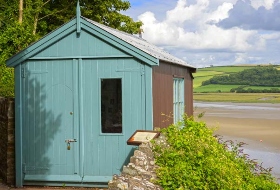Understanding listing
Page updated on: 31/08/2023
The prime purpose of ‘Listing’ is to protect buildings and structures of special historic or architectural interest and their surroundings from changes which would materially alter the character of these buildings and their settings. There is a requirement to obtain ‘Listed Building Consent’ when proposals to carry out alteration, extension or demolition works are being considered, and this is a safeguard to ensure that the special character of a building is fully taken into account.
Buildings are ‘listed’ when they are considered to be of special architectural or historic interest. This means that not only is your listed building important to you, but it is also important to your local community and contributes to the cultural heritage of Wales. The Welsh Government is required by law to compile lists of buildings of special architectural or historic interest and these lists are used to help planning authorities make their decisions in the interests of the built heritage.
Listed buildings are valuable assets that cannot be replaced. Many have probably already changed over time and many may need further changes in the future. Conservation is the careful management of change; this means finding the best option to protect and enhance the special qualities of listed buildings so that present and future generations can appreciate and enjoy it. Caring for listed buildings appropriately, and retaining them in sustainable use helps ensure that they continue to contribute to the cultural heritage and value of Carmarthenshire and Wales.
In Carmarthenshire there are 1,848 listed buildings ranging from castles, country houses, cottages, public buildings, farm buildings, historic walls and bridges and even phone boxes.
There are three categories of Listed Buildings:
- Grade I buildings are of exceptional interest. Only about 2% of Listed Buildings are in this category in Wales. In Carmarthenshire there are 24 Grade I listed buildings.
- Grade II* buildings are of particular importance. 4% of Listed Buildings are Grade II* in Wales, and in Carmarthenshire there are 120 Grade II*
- Grade II buildings are of special interest. 94% of all listed buildings are in this class and there are 1,704 in Carmarthenshire. This is the most likely grade of listing for a homeowner.
Buildings are listed by the Welsh Government for their special architectural or historic interest, for close historical association (with nationally important people or events) or group value. Age and rarity are also considerations. All buildings erected prior to 1700, remaining substantially intact are listed, as are most buildings constructed between 1700 and 1840, although some selection is necessary to identify the best examples. Much greater selection is required for buildings dating from 1840 as so many more still remain. Buildings less than 30 years old are normally only listed if they are of outstanding quality or potentially under threat.
In considering whether to list a building, the Welsh Government is advised by Cadw: Welsh Historic Monuments. Anyone can recommend a building to be listed. New provisions under the Historic Environment (Wales) Act 2016 ensures that owners will be formally consulted when a building or structure is being considered for listing, making the designation process more open and easily understood. Buildings and structures being considered for listing will receive interim protection intended to safeguard historic assets from damage or destruction during the consultation period. An owner or occupier will now also be able to request a review of a new designation decision in line with the provisions set out in the Historic Environment (Wales) Act 2016
As well as providing a ready reference of buildings of importance to the nation’s heritage, listing provides an added level of protection. This is in the form of a special planning procedure known as Listed Building Consent.
This protection is afforded to the building in its entirety and both the interior (including fixtures) and exterior of the building are protected, regardless of the grade. Any object or structure fixed to a listed building is also protected and this can include extensions (including modern additions), walls, porches and outbuildings.
Additionally structures or objects within the curtilage of a listed building which have been present on the land since before 1st July 1948 are also given protection. Such buildings and structures are known as ‘curtilage’ listed and can include outbuildings, walls, gates and gate piers, ice houses and pig sties etc.
Any works of alteration (including partial demolition), extension and repair to a listed building, which would affect its character as a building of special architectural or historic interest, require Listed Building Consent. If you are considering undertaking works to a listed building you are advised to contact the Built Heritage Team for further advice.
It is a criminal offence to carry out any works (either to the exterior or interior) which would affect the character of a building once it is listed, unless listed building consent has been obtained from the appropriate planning authority. This is enshrined in the Planning (Listed Building and Conservation Areas) Act 1990.
Works of routine maintenance or like-for-like repair are normally exempt from listed building controls, but please contact the built heritage team if you need any guidance in any particular case before any work starts.
Every heritage asset on the ‘Cof Cymru- National Historic Assets of Wales’ list gives a brief description of the assets most notable features. These descriptions can be found online by searching for the properties list entry on Cof Cymru section on the Cadw website.
These descriptions are a useful starting point to understand the heritage asset but are not intended to be comprehensive. They were originally only designed to identify the listed property, not to highlight all the important heritage credentials. In some cases they name specific architectural and historic characteristics of special interest, but rarely do they include all the elements which make that building important from a historic point of view.
Under the Historic Environment Act 2016 an owner is formally consulted when a building or structure is being considered for listing making the decision process more open and easily understood. An owner or occupier is able to request a review of a new designation decision in line with the act. If you are considering this please contact the Built Heritage Team to discuss it.
Any appeal would have to be based on information relating to the building’s architectural or historic interest and not to the effects of statutory protection upon development proposals.
Owning or looking after a listed building is a great responsibility. The building may be your home or your means for earning your income; it may be a new purchase or have been in your family for years; you may be undertaking repairs on it as a contractor or considering it as part of a regeneration project. Whatever your involvement with that building it is important to remember that it is listed to ensure that its special character is protected – that you are looking after it for future generations. Many of the reasons that you may love that building are because of its special character and it is your duty to protect it.
It is your responsibility to ensure that the property is maintained in a reasonable state of repair. There is no statutory duty to effect improvements, but you must not cause the building to fall into any worse state than it was in when you became its owner. This may necessitate some works, even if they are just to keep the building wind and watertight. However, you may need listed building consent in order to carry these works out.
If we believe that you are deliberately neglecting the property, or have carried out works without consent, enforcement action may be instigated. This might include us serving ‘Repairs Notices’, specifying works which need to be done in order to preserve the building and prevent further deterioration, or to reverse unauthorised works. Prosecution, leading to fines or imprisonment can follow and extensive deliberate neglect can result in a Compulsory Purchase Order.
A photographic record of the property when it came into your possession may be a useful asset, although if you have inherited incomplete or unimplemented works from your predecessor, you will also become liable for these.
When buying a listed building it is important to note that the ‘listing’ refers to the whole of the building.
When deciding whether to buy a listed building you should consider whether the building is able to accommodate your needs as it currently stands. Any changes to the building, including changes to internal layout and adding extensions are likely be subject to LBC and will not automatically be granted.
It is important to establish early on whether proposals will be acceptable.
Please send full details of your proposals to the Built Heritage team for their consideration. Whilst a quick phone call may be of some value in helping you make decisions on whether to purchase a property, the Built Heritage Officer will not be able to offer you clear guidance unless written details are provided. Please include the address of the property, details of the existing building and all your proposed changes, additions and alterations.
Alternatively you may wish to employ the services of a Conservation Architect or Heritage/Planning Consultant who can advise you further at this early stage. A full structural survey will provide information on the building’s materials, its general condition and any causes for concern. This information will be invaluable when maintaining or working on your building. We recommend using a professional familiar with historic buildings, preferably accredited by a professional body such as the Royal Institution of Chartered Surveyors or the Institute of Historic Building Conservation. Some professionals with recognised accreditation are listed on the directory on the Welsh Traditional Buildings Forum website.
If you decide to buy a listed building you might want to get advice from a specialist insurance broker or let your insurer know if your property is listed, as this may require specialist insurance. The cost of rebuilding a listed building is likely to be higher than for a standard property. A detailed specialist valuation from an accredited surveyor or architect can help you to decide on the most suitable insurance policy.
It is important to understand that responsibility for unauthorised works to a Listed Building is linked to ownership. Therefore your solicitor should establish, prior to exchange of contracts, whether works which have been carried out have been authorised.
Planning
Planning Application Guide
- Development Idea
- Do I need a Planning Agent?
- Key Information
- Pre-Application Stage
- Types of Planning Application
- Application submission
- Validation
- Live Application
- Planning Committee
- Appeals
- Compliance / Enforcement
- Completion of Development
Major Planning Applications
Extending / changing your home
- Lawful Development Certificate
- Pre-application advice service
- Householder planning permission
- Neighbouring properties / party walls
- Bats and nesting birds
- Conservation areas
- Listed buildings
Search for a Planning Application
Breach of planning
Change of Use (Planning)
Pre-application consultation (PAC)
Highways planning liaison
Development Viability Model (DVM) Assessment Tool
Sustainable Drainage Systems (SuDS)
Apply for Section 106 funds
Local Development Order (LDO)
Listed Buildings and Conservation Areas
- Understanding listing
- When is listed building consent required?
- Alterations to Listed Buildings
- Applying for listed building consent
- What happens after a decision on listed building consent has been made?
- Works to a listed building without consent
- Maintenance and Repair
- Further sources of information
- Conservation Areas
Conservation & countryside
Street naming and numbering
My Nearest - Planning information
Planning Policy
- Local Development Plan 2006 - 2021
- LDP Review Report
- Supplementary Planning Guidance (SPG)
- Affordable Housing
- Affordable Housing areas
- Annual Monitoring Report (AMR)
- Housing Land Supply
- Community Infrastructure Levy (CIL)
Local Development Plan 2018 - 2033
- Integrated Sustainability Appraisal and Habitats Regulations Assessment
- Delivery Agreement
- Candidate Sites
- Inspector’s Report and Adoption
- Submission and Independent Examination
- Second Deposit Revised Local Development Plan
- Preferred Strategy (Pre-Deposit Public Consultation)
- Development of an evidence base
- Frequently asked questions
- First Deposit Revised LDP
Renewable Energy
Planning Ecology
New phosphates targets
- What action have we taken?
- West Wales Calculator
- Mitigation Measures
- Next Steps
- Phosphates - Frequently Asked Questions
- Teifi Demonstrator Catchment Project
Biodiversity
- Why biodiversity matters?
- Priority Species in Carmarthenshire
- Priority Habitats in Carmarthenshire
- Carmarthenshire Nature Partnership
- HLF Bogs project
- Marsh fritillary project
- Hedgerows
- Woodlands
- Pollinators
- Get out and about!
- Legislation and Guidance
- Protected sites
- Ash dieback disease
- Wildlife in your Ward
- Local Places for Nature
Waste
More from Planning





